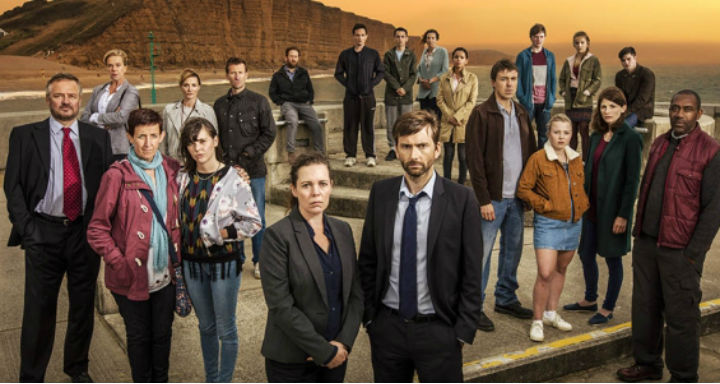Spotlight: Crime in the media spotlight as ITV's Broadchurch returns
Posted on Monday 27 February 2017

The final season of Broadchurch has started on ITV1
“The critically acclaimed ITV drama, Broadchurch, has returned to our TV screens for its final season. The winner of numerous television awards, the opening series of the drama explored what happened when a serious crime shook a small rural town on the Dorset coastline, and how the community, police, and media reacted to find the perpetrator.
The complex relationship between communities, the media, and the criminal justice system, highlighted by this series, is not just a feature of dramatic storytelling, but a significant research topic that explores the varying approaches different judicial systems take to inviting the media cameras into courtroom trials.
It is an issue that has come up most recently in the Oscar Pistorius trial in South Africa, and the case of Anders Breivik in the Norwegian massacre trial. Not forgetting of course, perhaps the most infamous example of media scrutiny - the OJ Simpson trial of 1994.
Jack the Ripper
Just how much media and community can influence the outcomes of criminal cases is not a new debate; it has been a major feature of global justice systems since journalists first put pen to paper.
Take one of the most notorious British crime mysteries - Jack the Ripper. In 1888, the violent murder of seven women in London’s East End was a print media sensation. Journalists reflected the growing public frustration that the perpetrator could not be found, with articles published using entertaining illustrations of police chiefs asleep in their offices whilst women stood on street corners in wait for the killer.
Newspaper reports told of the almost guerrilla style tactics local residents were willing to use to find the killer, which in turn fuelled a collective sense of fear and powerlessness in the face of violent crime.
Make or break
Whether the community and media involvement in this case influenced its outcome is still debated, particularly as the perpetrator was never found. But what historical cases, such as this, tell us is that the relationship between the justice system, the community and the media, can make or break a criminal case. It also provides valuable sources of information on how we as ‘outsiders’ feel about our place in society and how much power we have as an individual or as a community in deciding what justice really means.
The challenge in recognising the value of the media and community in such cases, is deciding whether the media provides a mirror to the justice system for a community to view and debate or whether it intentionally or inadvertently influences the course, and outcome, of a case by carrying the weight of societal expectation in its reporting.
It is a tension that we see throughout history.
Charles Lindbergh Jr
An example of a case where the media and the community played a direct role in the outcome of a criminal case is the kidnap and murder of Charles Lindbergh Jr in 1932, in the United States. The 20 month-old child was the son of famous aviator Charles Lindbergh, who was the first person to fly single-handedly from the US to France.
Much like the instantaneous nature of his father’s acquisition of fame, Lindbergh Jr’s kidnap made immediate international headlines. Communities around the world responded with a fervent desire to help in the search, the scale of which reflected a level of celebrity similar in scale to perhaps the kidnap of a royal child.
The child’s body was found two months after his disappearance but it took a further two years to find a perpetrator. The unprecedented media coverage of the case had planted the details of the story firmly in the community consciousness. The police actively liaised with the media to publicise the investigation in the hope it would help them catch the perpetrator. In September 1934, a gasoline station attendant reported a suspicious ten-dollar gold certificate, which was later discovered to be part of the ransom money paid to the kidnappers.
Media spectacle
The close cooperation between the community, the media and the criminal justice system caught the perpetrator; German immigrant Bruno Richard Hauptmann.
Hauptmann’s trial in Flemington, New Jersey was a public and media spectacle. After such a lengthy investigation, there was a strong public desire to see the killer. As a result, thousands of people flocked to the borough to be in with a chance of getting a seat at the trial.
Hauptmann was found guilty and eventually executed on 3 April 1936. Despite reaching a verdict, there was considerable concern, and indeed there still is, that because of the scale of public interest and expectation, media coverage of the case potentially jeopardised Hauptmann’s right to a fair trial.
Public expectation
The kidnap and murder of Charles Lindbergh Jr shows the role of the media as the access point for international communities to the American criminal justice system. But also, it shows how the media acts as a mirror, reflecting public needs and expectations. The media cast a light on a typically closed system, and gave a public institution its public face.
Research is ongoing into the value of media presence in the courtroom, but as history, and dramatizations such as Broadchurch, shows us, because of the information provided by the media, communities are able to rally together in alliance with the criminal justice system."
Notes to editors:
To find out more about Rosie's work, visit: https://www.york.ac.uk/sociology/our-staff/students/rosie-smith/
